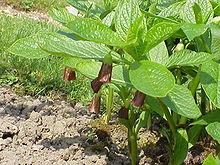Scopoletin
| Strukturformel | |||||||||||||||||||
|---|---|---|---|---|---|---|---|---|---|---|---|---|---|---|---|---|---|---|---|

| |||||||||||||||||||
| Allgemeines | |||||||||||||||||||
| Name | Scopoletin | ||||||||||||||||||
| Andere Namen |
| ||||||||||||||||||
| Summenformel | C10H8O4 | ||||||||||||||||||
| Kurzbeschreibung |
beiges Pulver[1] | ||||||||||||||||||
| Externe Identifikatoren/Datenbanken | |||||||||||||||||||
| |||||||||||||||||||
| Eigenschaften | |||||||||||||||||||
| Molare Masse | 192,17 g·mol−1 | ||||||||||||||||||
| Aggregatzustand |
fest[1] | ||||||||||||||||||
| Schmelzpunkt | |||||||||||||||||||
| Sicherheitshinweise | |||||||||||||||||||
| |||||||||||||||||||
| Soweit möglich und gebräuchlich, werden SI-Einheiten verwendet. Wenn nicht anders vermerkt, gelten die angegebenen Daten bei Standardbedingungen. | |||||||||||||||||||
Scopoletin ist ein Cumarin, das als sekundärer Pflanzenstoff weit verbreitet ist. Es kommt in mindestens 50 Arten vor und ist möglicherweise das häufigste Cumarin in Pflanzen.[2] Es ist strukturell eng verwandt mit Scoparon. Es ist das Aglycon der Glycoside Scopolin und Fabiatrin.
Vorkommen[Bearbeiten | Quelltext bearbeiten]

Scopoletin kommt unter anderem in den Wurzeln der Gattung Scopolia vor, wie z. B. Scopolia carniolica[3] und Scopolia japonica, aber auch in Chicorée, in Artemisia scoparia, in den Wurzeln und Blättern der Brennnessel (Urtica dioica), in der Passionsblume, in Brunfelsia, in Viburnum prunifolium, in Solanum nigrum,[4] und in Kleinhovia hospita.
Weiterhin kommt es in Arabidopsis thaliana[5], Saat-Hafer, Pflaume, Sonnenblume[6], Mallotus resinosus[7], Tabak[8], Maniok[9] und der Himmelblauen Prunkwinde[10] vor.
Scopoletin wurde auch in Essig,[11] manchen Whiskies und in Löwenzahnkaffee nachgewiesen.
Biosynthese[Bearbeiten | Quelltext bearbeiten]
Die Biosynthese in Maniok wurde intensiv untersucht. (E)-Zimtsäure, die aus Phenylalanin entsteht, ist hier ein Vorläufer von Scopoletin und dem Glucosid Scopolin. Diese wird enzymatisch zur (Z)-Zimtsäure isomerisiert.[9]
In Tabak verläuft die Biosynthese ausgehend von Phenylalanin vermutlich über die Coenzym-A-Addukte der Kaffeesäure, Ferulasäure und 6'-Hydroxyferulasäure.[12]
Biologische Bedeutung[Bearbeiten | Quelltext bearbeiten]
Scopoletin ist ein Phytoalexin, das Pflanzen zur Verteidigung gegen Pathogene dient.[12]
Die Biosynthese von Scopoletin in verschiedenen Pflanzen nimmt in Stresssituationen zu, z. B. bei Tabak durch Einwirkung von Methyljasmonat oder 2,4-Dichlorphenoxyessigsäure und bei virusbefallenen Tabak- und Kartoffelpflanzen.[6][8][12] Scopolin wirkt fungizid gegen Sclerotina sclerotiorum (Gattung Sklerotienbecherlinge) und Sonnenblumen, die bei einer Infektion verstärkt Scopolin produzierten, waren deutlich resistenter als andere.[13] Ebenso wurde bei der Himmelblauen Prunkwinde nachgewiesen, dass sie nach einer Pilzinfektion mit Fusarium oxysporum Scopoletin und Scopolin akkumuliert.[10]
Eigenschaften[Bearbeiten | Quelltext bearbeiten]
Scopoletin wurde in silico als möglicher Inhibitor der Acetylcholinesterase identifiziert. Die Wirkung hat sich bei Versuchen in vitro und in vivo (an Ratten) bestätigt.[3]
Verwendung[Bearbeiten | Quelltext bearbeiten]
Scopoletin wird in der Biochemie zur Proteinfärbung eingesetzt.[14]
Einzelnachweise[Bearbeiten | Quelltext bearbeiten]
- ↑ a b c d e Datenblatt Scopoletin, ≥99% bei Sigma-Aldrich, abgerufen am 9. Dezember 2015 (PDF).
- ↑ Frank A. Einhellig, Elroy L. Rice, Paul G. Risser, Simon H. Wender: Effects of Scopoletin on Growth, CO 2 Exchange Rates, and Concentration of Scopoletin, Scopolin, and Chlorogenic Acids in Tobacco, Sunflower, and Pigweed. In: Bulletin of the Torrey Botanical Club. Band 97, Nr. 1, Januar 1970, S. 22, doi:10.2307/2483987.
- ↑ a b Judith M. Rollinger, Ariane Hornick, Thierry Langer, Hermann Stuppner, Helmut Prast: Acetylcholinesterase Inhibitory Activity of Scopolin and Scopoletin Discovered by Virtual Screening of Natural Products. In: Journal of Medicinal Chemistry. Band 47, Nr. 25, 1. Dezember 2004, S. 6248–6254, doi:10.1021/jm049655r.
- ↑ Zhao Y, Liu F, Lou HX: [Studies on the chemical constituents of Solanum nigrum]. In: Zhong Yao Cai. 33. Jahrgang, Nr. 4, 2010, S. 555–556, PMID 20845784 (chinesisch).
- ↑ Y. O. Ahn, B.-i. Shimizu, K. Sakata, D. Gantulga, Z. Zhou, D. R. Bevan, A. Esen: Scopolin-hydrolyzing -glucosidases in roots of Arabidopsis. In: Plant and Cell Physiology. Band 51, Nr. 1, 1. Januar 2010, S. 132–143, doi:10.1093/pcp/pcp174.
- ↑ a b Frank A. Einhellig, Elroy L. Rice, Paul G. Risser, Simon H. Wender: Effects of Scopoletin on Growth, CO 2 Exchange Rates, and Concentration of Scopoletin, Scopolin, and Chlorogenic Acids in Tobacco, Sunflower, and Pigweed. In: Bulletin of the Torrey Botanical Club. Band 97, Nr. 1, Januar 1970, S. 22, doi:10.2307/2483987.
- ↑ Ma J, Jones SH, Hecht SM: A coumarin from Mallotus resinosus that mediates DNA cleavage. In: J Nat Prod. 67. Jahrgang, Nr. 9, 2004, S. 1614–1616, PMID 15387675.
- ↑ a b Manisha Sharan, Goro Taguchi, Keiichi Gonda, Takashi Jouke, Makoto Shimosaka, Nobuaki Hayashida, Mitsuo Okazaki: Effects of methyl jasmonate and elicitor on the activation of phenylalanine ammonia-lyase and the accumulation of scopoletin and scopolin in tobacco cell cultures. In: Plant Science. Band 132, Nr. 1, Februar 1998, S. 13–19, doi:10.1016/S0168-9452(97)00260-4.
- ↑ a b Soad A.L. Bayoumi, Michael G. Rowan, Ian S. Blagbrough, John R. Beeching: Biosynthesis of scopoletin and scopolin in cassava roots during post-harvest physiological deterioration: The E-Z-isomerisation stage. In: Phytochemistry. Band 69, Nr. 17, Dezember 2008, S. 2928–2936, doi:10.1016/j.phytochem.2008.09.023.
- ↑ a b Bun-ichi Shimizu, Hisashi Miyagawa, Tamio Ueno, Kanzo Sakata, Ken Watanabe, Kei Ogawa: Morning Glory Systemically Accumulates Scopoletin and Scopolin after Interaction with Fusarium oxysporum. In: Zeitschrift für Naturforschung C. Band 60, Nr. 1-2, 1. Februar 2005, S. 83–90, doi:10.1515/znc-2005-1-216.
- ↑ Analysis of polyphenolic compounds of different vinegar samples. Miguel Carrero Gálvez, Carmelo García Barroso and Juan Antonio Pérez-Bustamante, Zeitschrift für Lebensmitteluntersuchung und -Forschung A, Volume 199, Number 1, pages 29–31, doi:10.1007/BF01192948
- ↑ a b c J. Li, J. Wu: Scopolin, a Glycoside Form of the Phytoalexin Scopoletin, Is Likely Involved in the Resistance of Nicotiana Attenuata Against Alternaria Alternata. In: Journal of Plant Pathology. Band 98, Nr. 3, 2016, S. 641–644.
- ↑ E. Prats, M. E. Bazzalo, A. León, J. V. Jorrín: Fungitoxic effect of scopolin and related coumarins on Sclerotinia sclerotiorum. A way to overcome sunflower head rot. In: Euphytica. Band 147, Nr. 3, Februar 2006, S. 451–460, doi:10.1007/s10681-005-9045-8.
- ↑ Y. Chen, J. Yang, Z. Wang, X. Wu, F. Wang: Scopoletine as fluorescence probe for determination of protein. In: Spectrochimica acta. Part A, Molecular and biomolecular spectroscopy. Band 66, Nummer 3, März 2007, S. 686–690, doi:10.1016/j.saa.2006.04.012, PMID 16859971.
